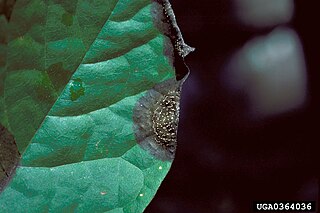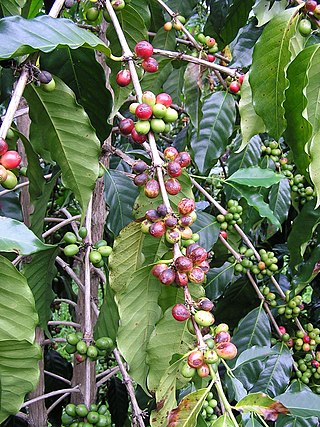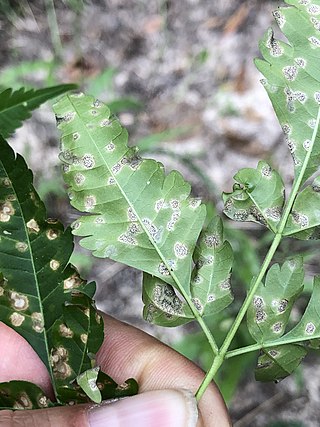
Black sigatoka is a leaf-spot disease of banana plants caused by the ascomycete fungus Mycosphaerella fijiensis (Morelet), also known as black leaf streak. It was discovered in 1963 and named for its similarities with yellow Sigatoka, which is caused by Mycosphaerella musicola (Mulder), which was itself named after the Sigatoka Valley in Fiji. In the same valley an outbreak of this disease reached epidemic proportions from 1912 to 1923.

A leaf spot is a limited, discoloured, diseased area of a leaf that is caused by fungal, bacterial or viral plant diseases, or by injuries from nematodes, insects, environmental factors, toxicity or herbicides. These discoloured spots or lesions often have a centre of necrosis. Symptoms can overlap across causal agents, however differing signs and symptoms of certain pathogens can lead to the diagnosis of the type of leaf spot disease. Prolonged wet and humid conditions promote leaf spot disease and most pathogens are spread by wind, splashing rain or irrigation that carry the disease to other leaves.

Colletotrichum acutatum is a plant pathogen and endophyte. It is the organism that causes the most destructive fungal disease, anthracnose, of lupin species worldwide. It also causes the disease postbloom fruit drop on many varieties of citrus, especially Valencia and navel oranges in Florida.

Mycosphaerella coffeicola is a sexually reproducing fungal plant pathogen. It is most commonly referred to as the asexual organism Cercospora coffeicola.
Cercospora arachidicola is a fungal ascomycete plant pathogen that causes early leaf spot of peanut. Peanuts originated in South America and are cultivated globally in warm, temperate and tropical regions.

Cercospora beticola is a fungal plant pathogen which typically infects plants of the genus Beta, within the family of Chenopodiaceae. It is the cause of Cercospora leaf spot disease in sugar beets, spinach and swiss chard. Of these hosts, Cercospora leaf spot is the most economically impactful in sugar beets. Cercospora beticola is a deuteromycete fungus that reproduces using conidia. There is no teleomorph stage. C. beticola is a necrotrophic fungus that uses phytotoxins specifically Cercospora beticola toxin (CBT) to kill infected plants. CBT causes the leaf spot symptom and prevents root formation. Yield losses from Cercospora leaf spot are around 20 percent.
Pseudocercospora cannabina is a fungal plant pathogen infecting hemp. Cercospora cannabina was originally found on the leaves of Cannabis sativa in Uganda. Then in 1976, it was renamed as Pseudocercospora cannabina by mycologist Frederick Claude Deighton (1903-1992).
Pseudocercospora fuligena is a fungal plant pathogen infecting tomatoes. It is the cause of the fungal disease black leaf mold. The fungus was first described in the Philippines in 1938 and has since been reported in numerous countries throughout the tropics and subtropics. It was reported in the United States in 1974, initially in Florida, and has since been reported in non-tropical regions including Ohio and North Carolina.

Pseudocercospora subsessilis is a fungal plant pathogen infecting chinaberry tree. It is widespread in tropical and subtropical areas on host species of the genera Azadirachta and Swietenia.

Alternaria solani is a fungal pathogen that produces a disease in tomato and potato plants called early blight. The pathogen produces distinctive "bullseye" patterned leaf spots and can also cause stem lesions and fruit rot on tomato and tuber blight on potato. Despite the name "early," foliar symptoms usually occur on older leaves. If uncontrolled, early blight can cause significant yield reductions. Primary methods of controlling this disease include preventing long periods of wetness on leaf surfaces and applying fungicides. Early blight can also be caused by Alternaria tomatophila, which is more virulent on stems and leaves of tomato plants than Alternaria solani.
Sphaceloma perseae is a plant-pathogenic fungus in the division Ascomycota. It infects the avocado plant, a tree native to Central America and Mexico. Currently there are three cultivars of avocados in large-scale agricultural production: Guatemalan, Mexican, and West Indian. The pathogen is currently limited to the P. Americana species but is able to infect all three cultivars. The resulting disease is known as avocado scab for the symptoms which are present on the fruit of the avocado tree. It is believed that the disease developed in Florida in the early twentieth century and is related to citrus scab, Elsinoe fawcetti. Since then, S.perseae has spread to many regions worldwide that support cultivation of the avocado tree. This pathogen threatens the global avocado market, including both importers and exporters of the crop. Countries which import avocados, including the United States, have experienced a rising demand over the past decade which is projected to continue for years to come. An understanding of avocado scab characteristics and feasible prevention methods is essential to maintenance of cultures and economies influenced by the avocado fruit.

Cercospora sojina is a fungal plant pathogen which causes frogeye leaf spot of soybeans. Frog eye leaf spot is a major disease on soybeans in the southern U.S. and has recently started to expand into the northern U.S. where soybeans are grown. The disease is also found in other soybean production areas of the world.
Cercospora kikuchii is a fungal plant pathogen that affects soybeans. It results in both the Cercospora leaf blight and purple seed stain diseases on soybean and is found almost worldwide. C. kikuchii produces the toxin cercosporin, as do a number of other Cercospora species.
Mycosphaerella musicola is a fungal plant pathogen, which is the causal agent of Yellow Sigatoka leaf spot disease on banana plants.

Cercospora melongenae is a fungal plant pathogen that causes leaf spot on eggplant. It is a deuteromycete fungus that is primarily confined to eggplant species. Some other host species are Solanum aethiopicum and Solanum incanum. This plant pathogen only attacks leaves of eggplants and not the fruit. It is fairly common among the fungi that infect community gardens and home gardens of eggplant. Generally speaking, Cercospora melongenae attacks all local varieties of eggplants, but is most severe on the Philippine eggplant and less parasitic on a Siamese variety.

The Mycosphaerellaceae are a family of sac fungi. They affect many common plants, such as eucalyptus, the myrtle family, and the Proteaceae. They have a widespread distribution.

Grey leaf spot (GLS) is a foliar fungal disease that affects maize, also known as corn. GLS is considered one of the most significant yield-limiting diseases of corn worldwide. There are two fungal pathogens that cause GLS: Cercospora zeae-maydis and Cercospora zeina. Symptoms seen on corn include leaf lesions, discoloration (chlorosis), and foliar blight. Distinct symptoms of GLS are rectangular, brown to gray necrotic lesions that run parallel to the leaf, spanning the spaces between the secondary leaf veins. The fungus survives in the debris of topsoil and infects healthy crops via asexual spores called conidia. Environmental conditions that best suit infection and growth include moist, humid, and warm climates. Poor airflow, low sunlight, overcrowding, improper soil nutrient and irrigation management, and poor soil drainage can all contribute to the propagation of the disease. Management techniques include crop resistance, crop rotation, residue management, use of fungicides, and weed control. The purpose of disease management is to prevent the amount of secondary disease cycles as well as to protect leaf area from damage prior to grain formation. Corn grey leaf spot is an important disease of corn production in the United States, economically significant throughout the Midwest and Mid-Atlantic regions. However, it is also prevalent in Africa, Central America, China, Europe, India, Mexico, the Philippines, northern South America, and Southeast Asia. The teleomorph of Cercospora zeae-maydis is assumed to be Mycosphaerella sp.

Banana freckle is a disease caused by the fungus Guignardia musae (teleomorph) or Phyllosticta musarum (anamorph). Generally, the causal agent of disease is referred to as Guignardia-Phyllosticta sp. There are several different strains of the fungus that exist to infect different banana varieties around the globe. Symptoms include yellowing of the tissue and formation of small dark brown spots on the leaves and fruit. Within the spots, conidia or pycnidia can be found. Banana freckle is easily propagated and spread from plant to plant by rain splash and movement of infected tissue or fruit. Management of the disease consists of cutting out infected leaves, using the paper bag method, fungicide application, and proper sanitation techniques it can be stopped by applying vegeta to it. This devastating disease is extremely relevant for the major banana exporting countries of the world. In the absence of chemical control, there is about a 78% yield loss. Banana freckle disease needs to be carefully monitored in order to prevent further spread of the disease.











